Lord Bobo commanded his minions to seduce Kam Raslan to conduct the first ever LoyarBerjalan to enlighten LoyarBurokkers on the forgotten history of Kuala Lumpur. This report was subsequently published in Selangor Times Issue 35, 29-31 July 2011 to enlighten more souls about the Malaysian capital sans Petronas Twin Towers.
Most of us know that Kuala Lumpur, otherwise known as KL, was founded by Kapitan Yap Ah Loy as a mining town during the 19th century. But have you ever stop to wonder how did KL, instead of older cities like Ipoh and Georgetown, ended up as our capital city? Also, how much do we know about the history of KL?
In order to satisfy its members’ inquisitive minds, LoyarBurok invited talented writer and director Kam Raslan to conduct a historical tour of the heart of KL on July 17. Kam has been researching the city’s history for his second book and has conducted a few such tours previously.
Starting from the Sultan Abdul Samad building, his 90-minute tour would lead us to discover the forgotten stories and the remnants of the British Empire in the heart of the city.
While we stood beside the Klang River on Jalan Mahkamah Persekutuan at the beginning of the tour, Kam told the 11 LoyarBurokkers present that KL was never destined to be the capital city of Malaya.
“Even when the notion of a possible independent country started emerging, it was never written in stone that this place would be the capital. We could really be standing in Georgetown, Ipoh or Singapore right now.
“I’ve been trying to piece together how KL came to be the capital,” he told the audience, which comprised lawyers, journalists, students and activists.
The author of Confession of an Old Boy pointed out that similar to Selangor, Perak also had many tin mines, an older city and towns. So why was KL selected as the capital, instead of Ipoh?
Remnants of the British Empire
Kam is still in the midst of researching, but he believes that the striking architecture and philosophy behind the Sultan Abdul Samad building was one of the reasons KL was chosen.
The century-old building is now dwarfed by skyscrapers around KL, but when it was first built by the British in the 1890s, the 40m-high clock tower and its shiny copper dome must have looked quite awe-inspiring.
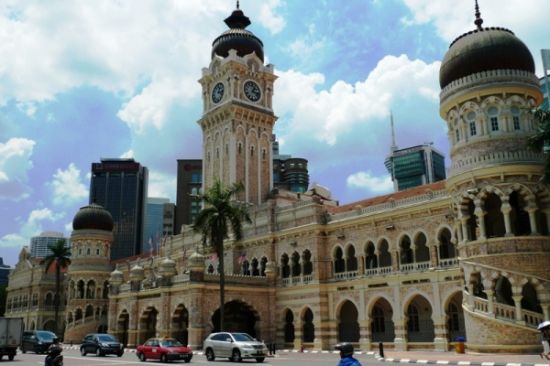
“Ipoh also has some fine buildings, but they only came later,” said Kam.
He revealed that the Sultan Abdul Samad building served a double purpose. Apart from housing important government departments during the British era, the colonisers also wanted to remind the locals that they owned India through the building’s Indian Muslim architecture.
The rationale was that if the British could conquer a huge country like India, then no one would dare to even dream of challenging the imperial power.
“Not that anybody [in Malaya] had such an idea. We don’t have a history of rebellion. The history books may have mentioned a few examples, but actually those can be read as inter-Malay struggle, and usually the side that teamed up with the British won,” Kam quipped.
Post-Independence, the Sultan Abdul Samad building was used to house the superior courts before the Federal Court and Court of Appeal were moved to Putrajaya and the High Court of Malaya to Jalan Duta a few years ago.
The historical building is now home to the Ministry of Information, Communication and Culture.
While we stood beside it and looked across towards Merdeka Square, Kam recounted that the St Mary’s Cathedral, located to the right of the field, was the spiritual centre of KL, while Selangor Golf Club situated behind the field was the social centre of KL,where games and fun activities were held.
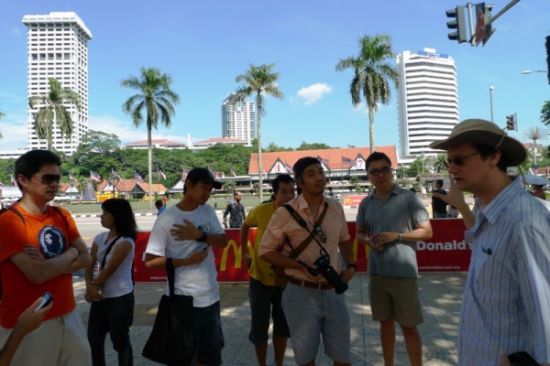
“The Sikh soldiers were so good that they always win the games, so they ended up having separate games instead…But there was also a biscuit-eating competition, once won by a young Malay.
“I’m telling this story because the history books now try to create an impression that the Malays were in a constant state of rebellion against the British, but I would like to remember this Malay fellow because…he was happy enough to take part in the competition,” said Kam.
But the St Mary’s Cathedral and the Selangor Golf Club are no longer the spiritual or social centre of KL today.
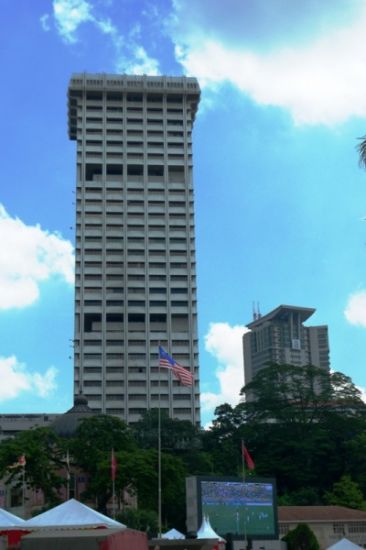
“The only key image of the British Empire that still lives on in this area is Bukit Aman,” Kam said, pointing towards the police headquarters towering above Merdeka Square.
“It was where the police and army were, and it’s still where the [national] police [headquarters] are today, reinforcing the image of control and mystery,” he said.
He explained that as the British were outnumbered, the colonisers had to rely on “smokes and mirrors” to maintain a psychological advantage over the locals. The tower on Bukit Aman created an impression that the authorities were watching the people and knew more than they really did.
Another significant point raised by Kam during the tour was that the British settlements were intentionally separated from Chinatown by the Klang River.
“If anyone (rebels) were to cross the river, they would also have to cross the field (Merdeka Square) and the troops would have a clear field to shoot. Worst comes to worst, the British could retreat into Bukit Aman,” Kam said.
He added that there used to be a gun at the top of the hill on Bukit Aman. It would be fired loudly every hour to intimidate the locals and remind them of the British’s military power.
Young migrants: Past and present
Moving on to Medan Pasar, we stopped in front of United Overseas Bank. Many young Bangladeshis, Nepalese and other nationalities could be seen hanging around the street.
One could imagine around a century ago, young men from China hanging around in the same spots after work.
“It’s essentially the same; they were here in search of a better life,” said Kam. But, he added, the Chinese men were mostly treated as slaves at that time.
The employer, or Kapitan, would pay for the workers’ trip from China to Malaya. As a result, the workers were already in debt before they had started work.
To add insult to injury, the workers were only paid every six months or a year, so they would have to buy everything – food, opium and other stuff – on credit for the year.
“In the end, the workers would usually discover that they owe more money to the Kapitan than they had earned that year, so they were trapped in this cycle and were essentially slaves,” Kam recounted.
The system was only abolished when the British Empire enforced a law to ban slavery throughout its colonies.
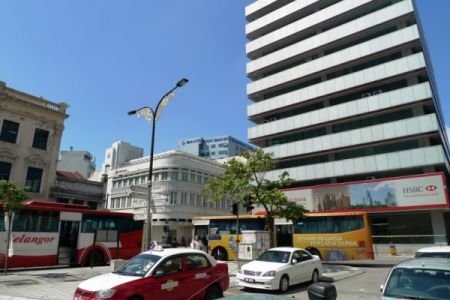
Across Leboh Pasar Besar was HSBC Bank, the site where the founder of KL Kapitan Yap Ah Loy used to stay, according to Kam.
“During the civil war, I heard Yap Ah Loy set up a table outside his house and offered a silver dollar for each head of his enemies…But after awhile they discovered that the same head kept turning up, so they abandoned the practice,” he said in jest.
Every river system was controlled by a Malay leader who would team up with a Chinese leader to exploit tin. During the Selangor civil war in the 19th century, one Malay-Chinese gang would fight with another Malay-Chinese group to wrest control of the rivers and tin mines.
Our last stop was the Sin Sze Si Ya Temple on Jalan Tun HS Lee. Founded by Yap Ah Loy in 1864, the temple was built to commemorate Yap’s former employer, Kapitan Shin Kap.
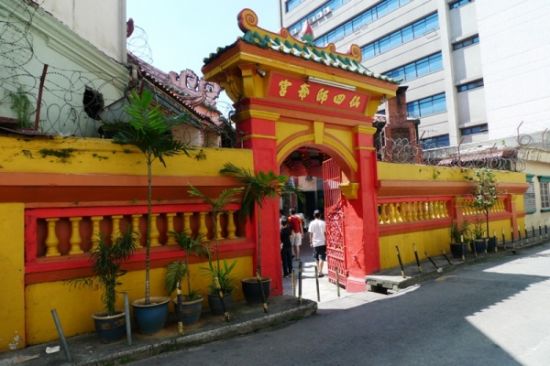
According to legend, Kapitan Shin’s blood was white when he was beheaded, so the Chinese began to worship him.
One of the oldest temples in KL, Sin Sze Si Ya Temple was once very popular. It used to hold processions through the streets during religious festivals but no longer does these days.
“We’ve forgotten our river”
Earlier on at the beginning of our tour at the Sultan Abdul Samad building, we also saw Masjid Jamek across the river.
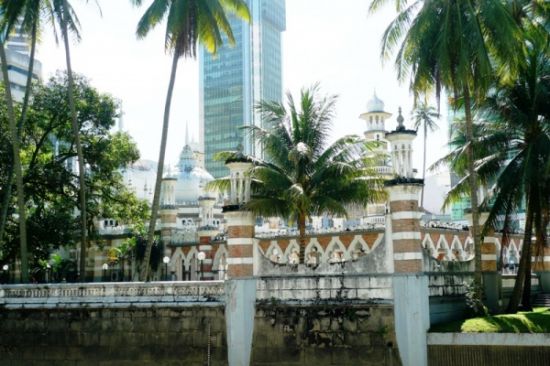
“It was built by the British for the Selangor Sultan because the British wanted to maintain the impression that they were [merely] governing the state on behalf of the Malay ruler,” Kam said.
He described the mosque, located at the point where the Klang and Gombak River converges, as the “prettiest” building around the area.
Constructed in the early 1900s, Masjid Jamek sits on a cemetery and was the city’s main mosque before Masjid Negara came along.
Before the river embankments were built, Kam said the river used to lap around the bottom of the steps of the entrance to the mosque.
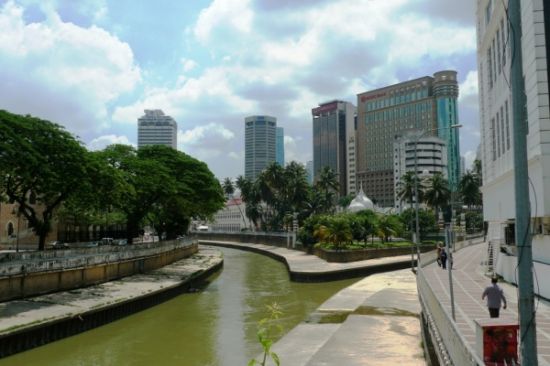
“In fact, there used to be sloping grass along the riverside that stretched all the way down the river, it was beautiful, but now we’ve pretty much forgotten about our river, treating it as a sewerage,” he lamented.
The Central Market, situated further down the river, has always been the market.
Believe it or not, Kam was told that Yap Ah Loy used to post men with guns to shoot crocodiles when animals were being transferred ashore from boats as the predators used to roam the river. But he has yet to find out when the last crocodile was sighted.
We would definitely be able to appreciate our country’s complex and unique history better, if only our history lessons were taught during walks like these, involving the narratives of the past and present.

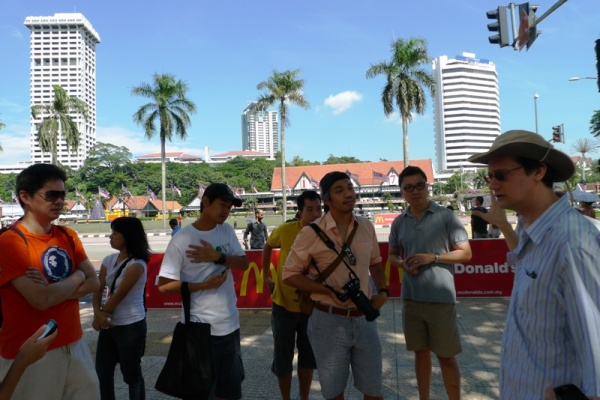
ns to seduce Kam Raslan to conduct the first ever LoyarBerjalan to enlighten LoyarBurokkers on the forgotten history of Kuala Lumpur. This report was subsequently published in Selangor Top Travel Blog Times Issue 35, 29-31 July 2011 to enlighten more souls about the Malaysian capital sans Pe
Bersih 2.0: Capturing The Spirit Of The Times – An essay and short story writing competition.
More than RM6,000 worth of cash, books and a cool limited edition diskopi's bersih t-shirt "melawan atas jalan bukan hanya atas talian" to be won.
For those interested to capture the zeitgeist of our era through essay or short story and won those prizes please check it out the details, terms and conditions of the competition at:
http://diskopi.wordpress.com
You can also download the competition poster in jpeg files at diskopi blog and publicised it in your blog. And please spread the good words to all your online and offline networkings.
Thanks.